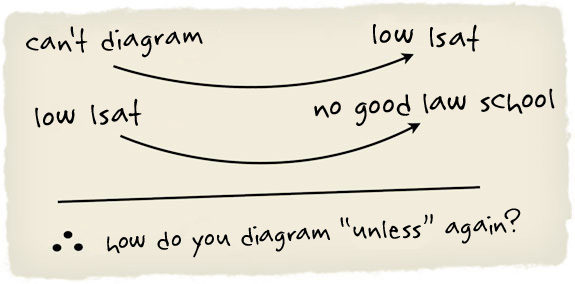
Diagramming Tips
The sun is out, barbeques and beach days are being planned, and people across the land are missing all of it because they’re staying indoors, studying for hours on end. The season of the LSAT is upon us. You might not get to experience much of summer, but there’ll be time enough for leisure in the park when you’re a handsomely-paid lawyer. Now is the time for LSAT study.
As you probably know by now, conditional statements are one of the most common things you’ll run across on the LSAT. At first, these can be terribly difficult to understand. One of the reasons for this is that there are so many different ways to express a conditional statement. The most basic form is “If A, then B,” but there are a number of ways to say the exact same thing; “All As are Bs,” “No As are not Bs,” “Being a B is required of being an A,” “Having A is sufficient for having B.” A huge part of improving your conditional reasoning skills is learning to recognize all the different permutations that these can show up in. Certain words can help you recognize which condition is sufficient and which is necessary. Words such as…
ONLY IF – When you see “only if,” you should take a second to thank the LSAT gods, because “only if” is super easy to diagram; whatever immediately follows “only if” is necessary. You don’t even need to think about it. Just put the part after “only if” on the right side. For example:
Only if you study hard will you do well on the LSAT.
What follows “only if?” “Study hard,” so that’s in the necessary:
Do Well LSAT → Study Hard
Really, that’s it. Memorize this, and you’ll never have any excuse to misdiagram another “only if” statement ever again.
ONLY – “Only” presents much more of a challenge than its cheap cousin “only if.” The way “only” works is that whatever it refers to is necessary. Sounds easy, but the hard part is figuring out exactly what “only” is referring to anyway. One thing that can help is asking yourself “only what?” What is the necessary thing they’re referring to? What do you have to have? For example:
The only way you can win a competitive eating contest is by eating hundreds of hotdogs every day to prepare.
Here, what is “only” referring to? Well, it’s referring to “way,” the way you could win an eating contest. But what is that “way?” Well, the way you would do it is by eating hundreds of hotdogs. That’s the only way you could ever win. So:
Win Eating Contest → Hundreds of Hotdogs Per Day
So remember, you’re looking what “only” is referring to. Because that is what will be necessary.
UNLESS/UNTIL/WITHOUT/EXCEPT – You should be able to rattle off these four words immediately at the drop of a hat, because, like with “only,” they’re a gift that makes diagramming incredibly easy. Whenever you see “unless,” “until,” “without,” or “except,” you can just replace them with “if not.” Seriously, that’s all you have to do. For example:
You can’t get in the bar without your ID.
“Without” immediately becomes “if not,” and you end up with:
You can’t get in the bar IF NOT your ID.
Which is now super easy to diagram:
NOT ID → NOT BAR
Or:
Unless you’re a millionaire, you’ll never go to space.
“Unless” just becomes “if not,” and you end up with:
NOT Millionaire → NOT Going to Space
If you haven’t memorized these yet, do so now. Start chanting “Unless, Until, Without, Except.” And it loudly.
So make sure to internalize all of these, and you’ll be on your way to mastering conditional statements. Mastering conditional statements will reap rewards all over the test, getting you significantly closer getting a great score and finally being done with this damn test.




